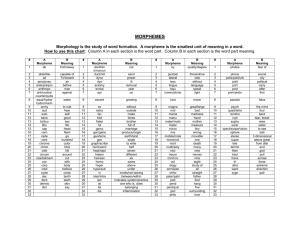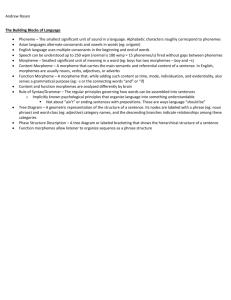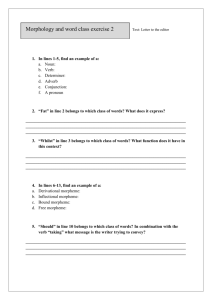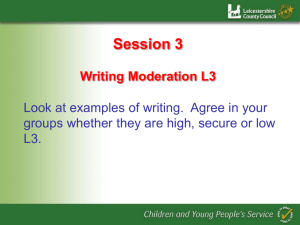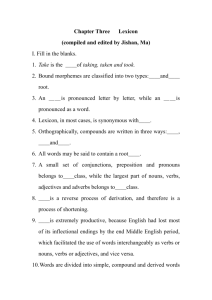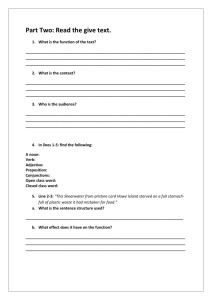Morphology 1 Why morphology matters?
advertisement
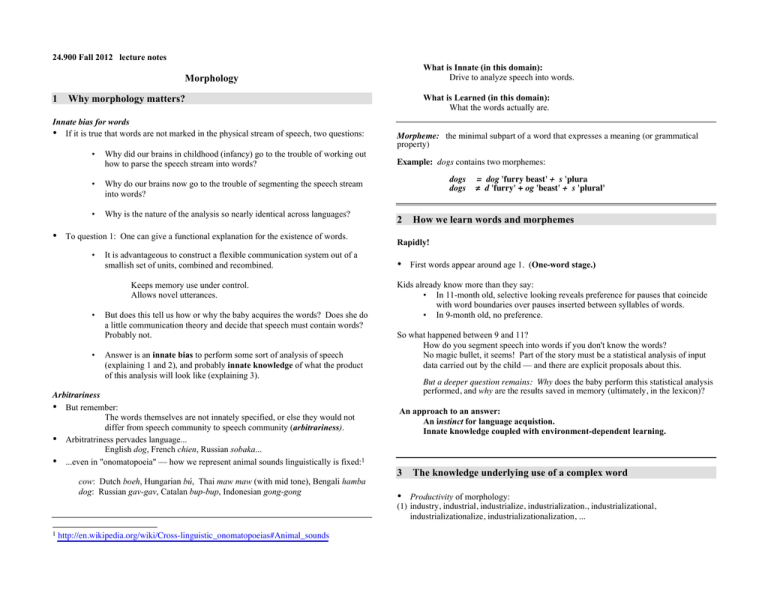
24.900 Fall 2012 lecture notes What is Innate (in this domain): Drive to analyze speech into words. Morphology 1 What is Learned (in this domain): What the words actually are. Why morphology matters? Innate bias for words • If it is true that words are not marked in the physical stream of speech, two questions: • Why did our brains in childhood (infancy) go to the trouble of working out how to parse the speech stream into words? Morpheme: the minimal subpart of a word that expresses a meaning (or grammatical property) Example: dogs contains two morphemes: dogs dogs • Why do our brains now go to the trouble of segmenting the speech stream into words? • Why is the nature of the analysis so nearly identical across languages? • To question 1: One can give a functional explanation for the existence of words. • It is advantageous to construct a flexible communication system out of a smallish set of units, combined and recombined. Keeps memory use under control. Allows novel utterances. • But does this tell us how or why the baby acquires the words? Does she do a little communication theory and decide that speech must contain words? Probably not. • Answer is an innate bias to perform some sort of analysis of speech (explaining 1 and 2), and probably innate knowledge of what the product of this analysis will look like (explaining 3). Arbitrariness • But remember: The words themselves are not innately specified, or else they would not differ from speech community to speech community (arbitrariness). • Arbitratriness pervades language... English dog, French chien, Russian sobaka... • ...even in "onomatopoeia" — how we represent animal sounds linguistically is fixed:1 cow: Dutch boeh, Hungarian bú, Thai maw maw (with mid tone), Bengali hamba dog: Russian gav-gav, Catalan bup-bup, Indonesian gong-gong 2 = dog 'furry beast' + s 'plura ≠ d 'furry' + og 'beast' + s 'plural' How we learn words and morphemes Rapidly! • First words appear around age 1. (One-word stage.) Kids already know more than they say: • In 11-month old, selective looking reveals preference for pauses that coincide with word boundaries over pauses inserted between syllables of words. • In 9-month old, no preference. So what happened between 9 and 11? How do you segment speech into words if you don't know the words? No magic bullet, it seems! Part of the story must be a statistical analysis of input data carried out by the child — and there are explicit proposals about this. But a deeper question remains: Why does the baby perform this statistical analysis performed, and why are the results saved in memory (ultimately, in the lexicon)? An approach to an answer: An instinct for language acquistion. Innate knowledge coupled with environment-dependent learning. 3 The knowledge underlying use of a complex word • Productivity of morphology: (1) industry, industrial, industrialize, industrialization., industrializational, industrializationalize, industrializationalization, ... 1 http://en.wikipedia.org/wiki/Cross-linguistic_onomatopoeias#Animal_sounds -2- • There is no termination to the process, except that the words become too long and their meanings too complex to keep track of all the morphemes. • An interesting difference between words and sentences: We have no problem parsing sentences with as many words as industrializationalization has morphemes (7 of them!) -- compare even the process of turning a question about something else into a question about industrialization, which has the same meaning but 14 words! The multi-word phrase is much easier to understand than the multi-morpheme word. We are not as good at parsing words as we are at parsing sentences. • Distinctions: bound morpheme vs. free morpheme / open-class vs. closed-class Industry is a word on its own. free morpheme -ize, -al, and -ation are not. bound morpheme • The free morpheme industry belongs to an open class of lexical items, an extendible class of items with a wide range of meanings. You can make up new ones, and are not surprised to learn new ones even in adulthood: screeve, Obama, cromulent. Because the real poem truly is written in English (because its closed-class items are English), the notion "translating Jabberwocky" into a foreign language is a meaningful one, and lots of translations have been made. • free vs. bound ≠ open vs. closed class • For example: There are free closed-class morphemes (prepositions, pronouns, articles...) There are bound open-class morphemes (un+kempt, sanit+ize) 4 How to build a morphologically complex word: the rule Merge You have to start somewhere! Step 0: • The opposite of "open class" is "closed class" (also known as "function words"). • Take a morpheme from the lexicon whose lexical entry does not say "I am a suffix" or "I am a prefix"... This starting point, which (as the textbook says) carries "the main meaning of the sentence", is the called root. Since open class items can be coined at will (more or less), it is really the closed-class items that identify the language — that make English English, make French French etc. Lewis Carroll's poem Jabberwocky contains lots of unfamiliar ("nonsense") open-class items, but all its closed-class items — all its function words — are English. Crazy though the poem may sound, it is clearly a poem written in English! ’Twas brillig, and the slithy toves Did gyre and gimble in the wabe; All mimsy were the borogoves, And the mome raths outgrabe. Compare a version in which the open-class words are replaced with normal English, but the function words are replaced with "non-sense". It no longer looks like English: Glorm cloudy, yurk lim noisy frogs Rur croak yurk fidget uf lim lake; Caj nervous trid lim hunting dogs, Yurk lim hungry cats lay awake. Or worse, replace both function words and open-class items with made-up words: Glorm brillig, yurk lim slithnit tovem Rur gyre yurk gimble uf lim wabe; Caj mimsnit trid lim borogovem, Yurk lim mome rathem nusgrabe. • Putting aside a special kind of complex word called a compound (to which we return next week) — if there's a free morpheme in the word, it's the root. Step 1: • A morphological rule that we can call "Merge" takes an appropriate morpheme from the lexicon and glues it to the root. (We return soon to what we mean by "appropriate".) • A non-root morpheme in a word is called an affix. So morphologically complex words are made up of a root and some number of affixes. -3- The lexical entry for each morpheme specifies 1. its sound 2. its meaning 3. whether it is a root or affix 4. its part-of-speech (category): N, V, A... 5. if it is an affix, the part of speech it merges with: 6. if it is an affix, its place of attachment: a. left edge (prefix) b. right edge (suffix) [c. after the first syllable, before the last syllable, before the main stress... (infix)]2 • An argument against this: find a prefix that makes a noun (or adjective) into a verb! The prefix en- (sometimes em-) forms verbs out of nouns (and adjectives): body --> embody trance --> entrance power --> empower Now notice that these verbs can take the suffix -ment. Even though the morpheme next to -ment is not a verb morpheme, structurally -ment is being added to a verb. 6 Step 2: • The output of step 2 can undergo Merge again. Another affix can be attached to it. • The element to which an affix attaches (whether a root or a morphologically complex word) is called its base. • When an affix attaches to the root, the root is also its base. But when an affix attaches to a an already complex form, its base is not the root. 5 In English, the fact that a noun is singular is not represented by an overt morpheme (one can say there is a zero morpheme) — though plural is a morpheme with a sound of its own (dog vs. dog-s). is a copy of sounds already present in the base. This is called reduplication: • A tree diagram can illustrate the internal structure of a word, and reflects how it was formed by one or more operations of Merge. [see the textbook for lots of actual trees] • Words really are trees (structures) -- not just strings of morphemes For example ... the suffix -ment attaches to a verb and produces a noun: government adjournment treatment amusement body —X→ *bodiment trance —X→ *trancement power —X→ *powerment • You might say: "the morpheme next to -ment must be a verb" as an alternative to "the base to which -ment attaches must be a verb". 2 • Whether a morpheme even has a sound is arbitrary. • Some morphemes that do have a sound do not have a sound of their own. Their sound Trees govern adjourn treat amuse "Sound" in more detail Discussed below. Example 1: Lakhota (Siouan, S. Dakota) sg gí ská ʃá thó ʒí inanimate pl gigí skaská ʃaʃá thothó ʒiʒí 'to be rusty brown' 'to be white' 'to be red' 'to be blue or green' 'to be yellow' Sound: Copy first CV of the base. Example 2: Ilocano (Austronesian, Phillippines) sg plural píŋgan piŋpíŋgan tálon taltálon dálon daldálon bíag bibíag nuáŋ nunuáŋ úlo ulúlo múla mumúla táwa tawtáwa 'dish' 'field' 'road' 'lives' 'carabao' 'head' 'plant' 'window' -4Example 3: Latin forms of the verb meaning 'love' • In the lexical entry for plural, under the heading "sound", it says not -ness, or un-, but: "Copy first (C)V(C) of the base." [C = consonant, V = vowel, parentheses = "if present...") present past future ama-s ama-ba-s ama-bi-s she/he/it... ama-t ama-ba-t ama-bi-t you (sg)... • Reduplication is extremely common in languages of the Austronesian group (Phillipines, Malaysia, Indonesia) we... ama-mus ama-ba-mus ama-bi-mus you (pl.) ama-tis ama-ba-tis ama-bi-tis I ... am-(a)-o ama-ba-m ama-b(i)-o they ... ama-nt amaba-nt ama-bu-nt but: 7 Allomorphs • Sometimes the sound of a morpheme depends on the base to which it is attached, but is The underlined bits are unexpected, and show allomorphs of the suffixes visible elsewhere in the chart. Example 1: English plural depends on the identity of the base to which it attaches. 8 not a copy of that base. Such a morpheme will have different arbitrary (i.e. not copied) sounds depending on the base to which it attaches. These variants are called allomorphs. dog-s, cat-s, horse-s but... ox-en child-ren sheep-ø, deer-ø Note that the -s plural is productive. It is the default plural marker which we apply in the absence of special knowledge about an irregular plural marker. What is the plural of wug? The situation is more complicated still: the default affix is -z, which regular phonology changes to /s/ for reasons we will discuss later. But after -s, -z, -ch, -sh, -j we get a vowel as well. This is more allomorphy... "Place" in more detail Point 1: The place of attachment must be listed in the lexicon, because it's arbitrary. • For example, whether a morpheme with a particular affix is a prefix or a suffix varies across languages. Example 1: Russian vs. Bulgarian comparative and superlative affixes. [I think I didn't do this one in class, but here it is anyway] Bulgarian: Russian: smešna / po-smešna smešna / smešn-ee 'funny' / 'funnier' umna / po-umna umna / umn-ee3 'smart' / 'smarter' What is the plural of gruss? Example 2: The affix meaning (roughly) -ness is a prefix in Kanuri, but a suffix (as in English) in Kurdish. It's also worth noting that English -ness attaches only (mostly) to adjectives, while its Kurdish cousin also attaches to nouns Sometimes the plural involves a change of vowel: mouse/mice, woman/women. Kanuri (Nilo-Saharan, Nigeria) Example 2: English past tense: Default is -d, but here too we have vowel changes, and sometimes both: walk/walked, industrialize/industrialized run/ran, sing/sang, lead/led, strive/strove sleep/slept gana kura kurugu karite dibi 'small' 'big' 'long' 'excellent' 'bad' nəәmgana nəәmkura nəәmkurugu nəәmkarite nəәmdibi 'smallness' 'bigness' 'length' 'excellence' 'badness' 3 Ignore for present purposes the -a of umna, which is a morpheme marking it as a feminine adjective of a particular sort. -5Kurdish (Indo-Iranian, Iraq) aaqil diz draiʒ zaanaa garm (2) 'wise' 'robber' 'long' 'wise' 'warm' aaqilii dizii draiʒii zaanaaii garmii 'forethought' 'robbery' 'length' 'erudition' 'warmth' fuckin'-infixation Infix fuckin' to the left of the syllable that bears main stress. Thus: (3) but not : a. Massa-fuckin'-chusetts b. *Massachu-fuckin's setts. — because the syllable -chu- bears the main stress. Likewise: We know: prefix (attach to left edge of base), suffix (attach to right edge of base) • Now: Infix! Attach inside the base, according to a rule that refers to the base's sound structure. Example 1: Bontoc (Austronesian, Philippines) The infix -um- is positioned following the initial consonant of the base. fikas kilad bato fusul 'he is becoming ...' fumikas kumilad bumato fumusul 'strong' 'red' 'stone' 'enemy' Example 2: Samoan (Austronesian, Samoa) This example is interesting because it is also reduplication: "copy penultimate syllable and position it next to the original" 'he ...' 'they ...' manao mananao 'wish' matua matutua 'be old' malosi malolosi 'be strong' punou punonou 'bend' savali savavali 'travel' pese pepese 'sing' laga lalaga 'weave' atamaʔi atamamaʔi 'be wise' galue galulue 'work' aloga alologa 'love' In these cases, the morpheme is attached in the middle of the sounds belonging to another morpheme. This type of affixation is called infixation. Example 3: fuckin' infixation (fan-fuckin'-tastic, Massa-fuckin'-chusetts, Missi-fuckin'ssippi)4 • The infixation of fuckin', which denotes a strong positive or negative attitude, appears to be determined by stress (accent). A first approximation at the correct rule is: 4 In British, Irish, Australian and New Zealand English, bloody can be used, and appears to follow exactly the same rule: Massa-bloody-chusetts, *Massachu-bloody-setts, etc. (4) but not: nor: a. Conn-fuckin'-ecticut [it helps to pause after the first syllable, or to draw it out] b. *Connect-fuckin'-icut. c. *Connecti-fuckin'-cut. • This example shows that the rule does involve stress, and not counting syllables from the end. since the stress in Connecticut falls on the third syllable from the end (the antepenult), while the stress in Massachusetts falls on the next-to-last syllable (the penult), as we've seen. (5) un-fuckin'-believable • What is especially worth noting about the whole phenomenon is that it really is rulegoverned! We have clear intuitions about good vs. bad places to infix fuckin' within bases to which we have surely never heard this infixation rule applied. • People sometimes think that parental input and correction is a key to language acquisition. Pretty unlikely here: ("No my little sweetheart, you know we don't say Massachu-fuckin'-setts. Say it properly, or you can't have dessert: Massa-fuckin'chusetts. Very good!"). 9 Multiple affixes • In many languages, verbs or nouns bear a whole group of affixes. Often these affixes mark agreement: they represent properties like "plural" or "3rd person" that have no meaning on the verb, but agree with a plural or 3rd person word or phrase somewhere else in the sentence. • These agreement affixes often make it possible to leave out the plural or 3rd person words, and just use a verb to express thoughts like "we saw him". • Languages with complex morphology of this sort present nice puzzles that will plague your problem sets and exams in this class! MIT OpenCourseWare http://ocw.mit.edu 24.900 Introduction to Linguistics Fall 2012 For information about citing these materials or our Terms of Use, visit: http://ocw.mit.edu/terms.

